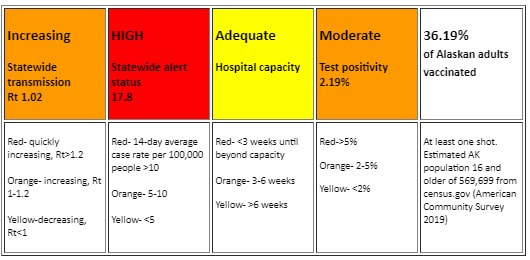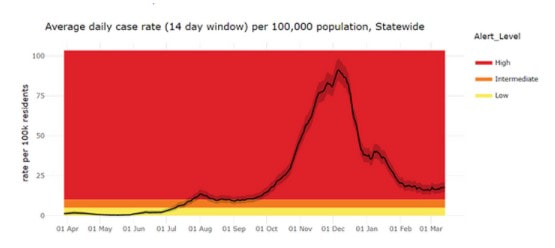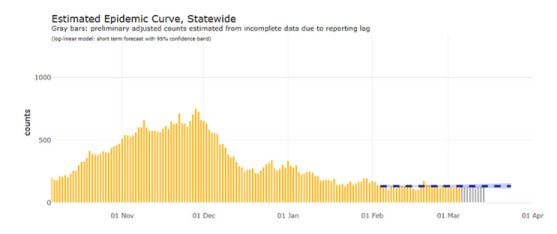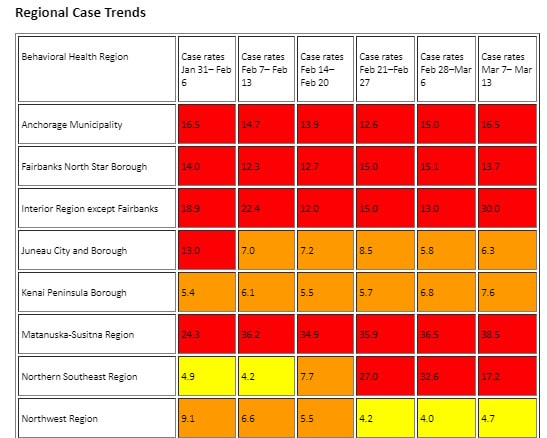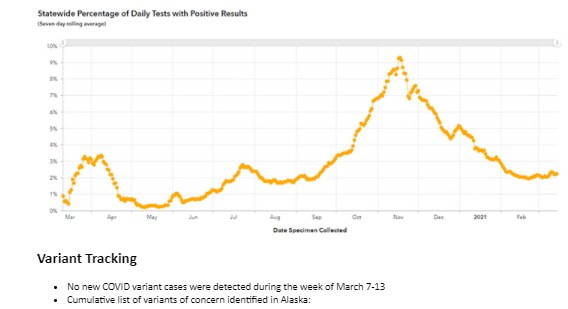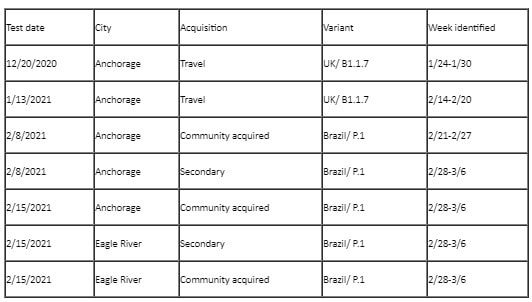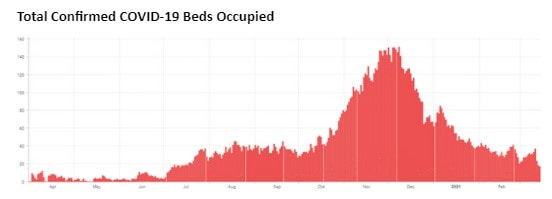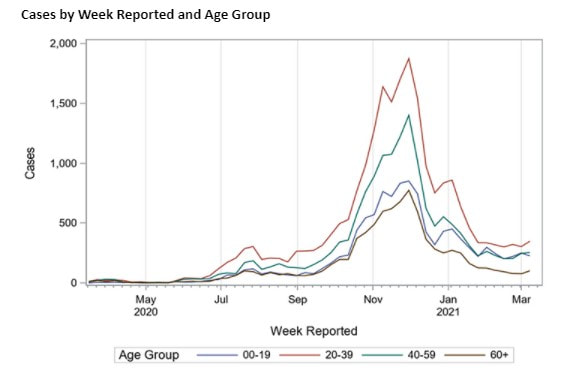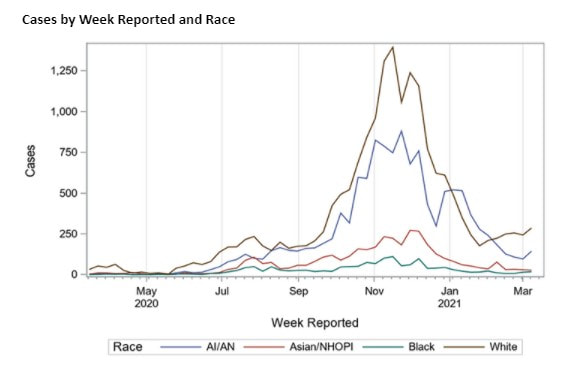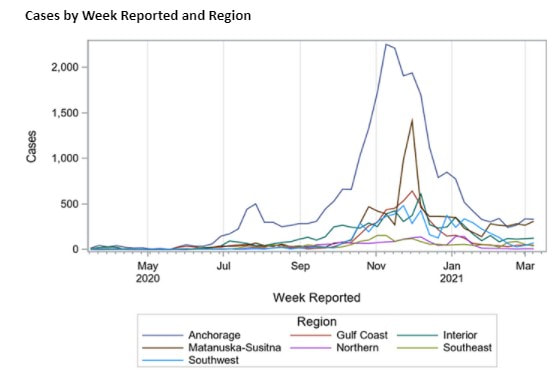Alaska Department of Health & Social Services Weekly Case Update
March 7-13, 2021
Brief Status Report
- Virus transmission remained stable across Alaska with slight increases in daily case rates and test positivity. Several regions continue to see small but steady increases in cases and others continuing to see slow decreases.
- Anyone 16 years or older who lives or works in Alaska is eligible to receive a COVID-19 vaccine. Alaska is the first state to offer vaccines to everyone over a certain age without prerequisites.
- More vaccinations lead to fewer COVID-19 illnesses, hospitalizations, and deaths. Vaccinations are the key to ending this pandemic.
- Alaska is currently the most vaccinated state per capita. 67.6% of the State/IHS vaccine allocation so far has been administered.
- DHSS encourages all Alaskans who are currently eligible for COVID-19 vaccination to make appointments as soon as possible by visiting covidvax.alaska.gov or by calling 1-907-646-3322. The call line is staffed Monday-Friday from 9AM-6:30PM and 9AM-4:30PM on weekends. Eligibility information can be found at covidvax.alaska.gov. Alaskans receiving health services through a Tribal Health Organization or the Department of Defense should contact those organizations directly to determine their eligibility.
- No new COVID variants of concern were detected in Alaska during the past week.
- Every Alaskan who chooses to wear a mask, stay 6 feet from others, avoid indoor gatherings, and get vaccinated helps protect themselves and the health of all Alaskans. These are our best tools to decrease the chance of a new variant entering Alaska and spreading.
- Fully vaccinated people can visit with other fully vaccinated people indoors without wearing masks or socially distancing. They can also visit with unvaccinated people from a single household who are at low risk for severe COVID-19 without wearing masks or socially distancing. Vaccinated people can also refrain from quarantine and testing following a known exposure to someone with COVID-19 so long as the vaccinated person is asymptomatic. We expect that CDC guidelines for people who have been vaccinated will continue to be updated as new evidence becomes available.
- To stop COVID-19, including new strains of virus, from coming into Alaska and spreading, testing within 72 hours before returning to Alaska or on arrival and then strict social distancing until the test result is available is recommended. A second test 5-14 days after arrival is also recommended if the traveler is not fully vaccinated. As of Jan 26, 2021, the CDC requires international travelers to show proof of a negative test from within the last 72 hours on arrival back in the US.
- CDC guidelines recommend regular asymptomatic testing for critical infrastructure workers and other groups at higher risk for COVID-19.
- Alaskans should get tested immediately at the first sign of any symptoms. Tests work best when obtained promptly after symptoms start. Testing early helps people know if they are positive quickly and helps prompt them to take immediate precautions to minimize the risk of transmitting the virus to others.
- Most Alaskans get COVID-19 from a friend, family member, or coworker. Many Alaskans who are diagnosed with COVID-19 report that they went to social gatherings, community events, church services, and other social venues while they were contagious but before they knew they had the virus.
- Alaskans should avoid indoor gatherings with non-household members, avoid crowds, wear masks when around non-household members, and stay 6 feet from anyone not in their household.
Case Trends and Predictions
- 929 cases were reported in Alaskans last week. This is a 8.0% increase from the week before and still reflects continued high-level community transmission throughout much of Alaska.
- 14-day average daily case rates were similar in most regions of Alaska compared with last week. The Anchorage case rate increased to 16.5 from 15.0 with a low of 12.6 two weeks prior. The Interior Region except Fairbanks increased to 30.0 from 13.0. Northern Southeast Region case rate increased from 27.0 to 32.6. The Northern Southeast Region case rate decreased from 32.6 to 17.2.
- Persistently high case rates continue in Matanuska-Susitna Region increasing to 38.5 from 36.5. This is the region’s third week of increasing rates.
- The estimated statewide daily growth rate as of March 14, 2021 is 0.01% and new cases are expected to double every 5,206 days based on current modeling, a little faster than last week.
Reported vaccinations as of March 15, 2020.
- The State of Alaska is working with federal, local, Tribal, and military partners to ensure that the distribution of vaccine goes as quickly and smoothly as possible.
- Anyone 16 years or older who lives or works in Alaska is eligible to receive a COVID-19 vaccine. All registration for vaccines should go through the registration system on covidvax.alaska.gov
- A limited amount of vaccine is currently available with more expected to be delivered in the coming months. On March 15, the New York Times vaccination tracker had Alaska as the second highest state by percent of the population that has received at least one shot, at 28%, and two shots, at 18%. The Alaska vaccine tracker is available online as is a vaccine dashboard for more up-to-date data.
- There is a several day lag in reporting some vaccinations so the dashboard does not yet reflect all vaccinations that have been given.
- Three vaccines are currently available in Alaska: Moderna and Pfizer vaccines are mRNA vaccines. The Johnson & Johnson/Janssen vaccine is an adenovirus-vectored technology.
- There are no plans to mandate a vaccine at the state level.
- The national Advisory Committee on Immunization Practices (ACIP) is responsible for providing national recommendations for vaccine administration and allocation.
- More vaccinations lead to fewer COVID-19 illnesses, hospitalizations, and deaths.
- Healthcare providers play a key role in building public confidence in the COVID-19 vaccine. In addition to their roles as health advisers, protectors, and advocates, healthcare personnel were the first group offered COVID-19 vaccinations. Health workers are a trusted voice that can have a powerful influence on their families and communities when it comes to getting the COVID-19 vaccine.
- Encourage leaders in your family, community, or organizations to be vaccine champions.
- Have discussions about COVID-19 vaccines where people can openly discuss their views and ask questions.
- Share key messages through multiple channels that people trust and that promote action.
- Help educate people about COVID-19 vaccines, how they are developed and monitored for safety, and how individuals can talk to others about the vaccines.
- Learn more about finding credible vaccine information. When you come across COVID-19 information, cross-check with CDC.gov and learn how to respond to misinformation you encounter.
- When vaccine is offered to you, make visible your decision to get vaccinated and celebrate it!
- During the week of March 7 through March 13, 2021, 929 new Alaska cases were reported, an 8% increase from last week, for a total of 58,061 cumulative cases reported in Alaskans.
- Cumulative hospitalizations increased to 1,279 with 8 reported as occurring this week. Hospitalization reports often lag and only 1,258 hospitalizations were reported at this time last week, so there are 21 hospitalizations newly reported this week including ones that began during previous weeks.
- Deaths among Alaska residents increased by 1 (302 total). None of these deaths occurred during this past week. It is common to take more than a week for a death to be reported, and more deaths that occurred during Mar 7–Mar 13 may be reported in future as death certificates are reviewed.
- 35 new nonresident cases were identified this week, for a total of 2,494 cases.
- Five cases of P.1, a variant of concern have been identified so far in Alaska. All five were in the Anchorage/Eagle River area. Three of the cases are linked; investigation is ongoing. Alaska’s Public Health Laboratories continue to monitor for variants of concern as well as for other variants of interest.
- Two cases of B.1.1.7, a variant of concern have been identified so far in Alaska. Both were in the Anchorage/Mat-Su area. Both were associated with travel.
- Alaska’s Public Health Laboratories continue to monitor variants of interest, such as the B.1.429 variant first identified in California which may be associated with increased transmissibility.
- On March 15, 32 Alaskans with confirmed COVID-19 were hospitalized and 2 were reported to require a mechanical ventilator.
- Hospital staffing can change quickly, particularly if a community has many health workers impacted by COVID-19.
Additional informational resources
- The State of Alaska COVID-19 vaccine status update page.
- The State of Alaska COVID-19 information page provides more information about the virus and how individuals and businesses can protect themselves and others from transmission.
- For the most up-to-date case information, see the Alaska Coronavirus Response Hub dashboard (note: some data may change as more information comes to light through contact tracing and other public health work).
Are you looking for a shipping solution? Maybe you need to change freight carriers? Find out what the hard working and reliable people at Team Worldwide can do over land, sea and air


